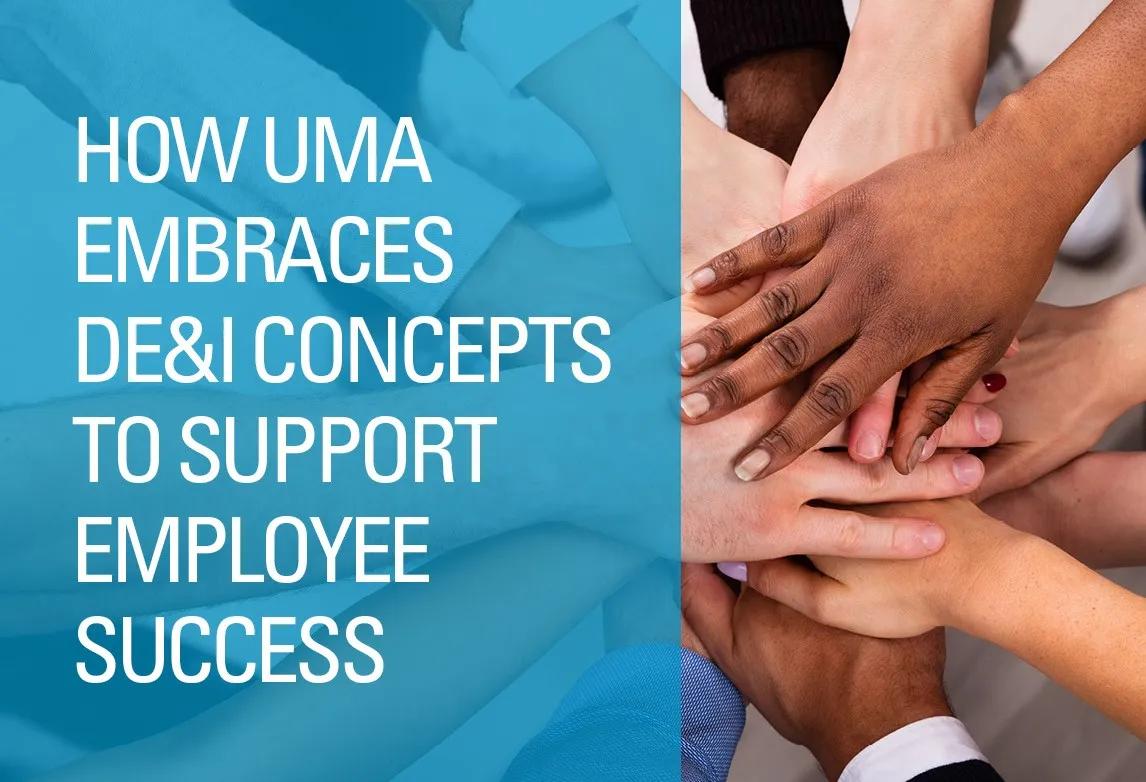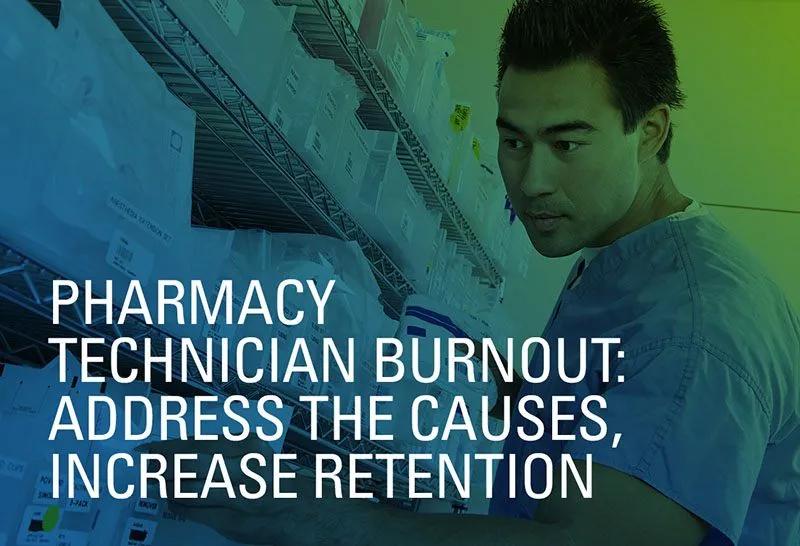
How UMA Embraces DE&I Concepts to Support Employee Success

UMA has a mantra of care. One of the ways we care for our students, grads, and employer partners is by promoting diversity, equity, and inclusion – often referred to as DE&I for short – within the healthcare workforce and our own team. Why is this initiative so important and what is UMA doing to support it? We’ll break each of these questions down. But first, it’s important to establish what DE&I means.
What Is DE&I?
Although we often use DE&I as a collective term, each component references a different aspect of this overarching concept.
- Diversity is defined, in part, as “the inclusion of people of different races, cultures, etc. in a group or organization.”1
- Equity refers to “justice according to natural law or right,” or, more specifically, “freedom from bias or favoritism.”2
- Inclusion encompasses both “the act of including” and “the state of being included.”3
Based on these definitions, DE&I involves taking actions to actively include people from all races, cultures, and statuses, and doing it in a way that each person feels respected, accepted, valued, and dealt with fairly.
Why DE&I Is Important in Healthcare
Diversity, equity, and inclusion are all important concepts within the workforce in general. However, they serve another valuable purpose when part of the healthcare workforce.
An article published in the Journal of the National Medical Association explains it well, stating:
“It is important to have a healthcare workforce which represents the tapestry of our communities as it relates to race/ethnicity, gender, sexual orientation, immigration status, physical disability status, and socioeconomic level to render the best possible care to our diverse patient populations.”4
Put another way, patients come from a variety of backgrounds. Having access to healthcare workers from similar backgrounds, and with similar experiences, can positively affect patient care. Research supports this premise.5
The Link Between DE&I and Employee Success
A diverse workplace means greater exposure to different perspectives, which can improve employee productivity.6 Additionally, studies have found that there is a relationship between productivity and employee satisfaction.7
When employees have higher levels of satisfaction in their workplace roles, they’re more likely to stay with their employer.8 This is good from a retention standpoint while also enabling the employee to focus on knowledge and skill development without having to learn a new employer’s policies and processes.
Exposure to the many perspectives that exist within a diverse work environment can also increase innovation.6 Workers may be inspired to find newer and better ways to do things, for example, potentially improving the speed and efficiency with which they’re able to perform their job tasks.
Ultimate Medical Academy’s DE&I Initiatives
UMA is committed to supporting and promoting DE&I in its workforce. Here are some of the actions we’ve taken in pursuit of this goal:
- In 2018, we established our D&I Council. In 2021, “equity” was added as a third focus of our organizational culture, expanding our attention to include this important aspect to our DE&I efforts.
- We’ve also established several Employee Resource Groups (ERGs) to better support workers from a variety of backgrounds and experiences. One such group is PAW Pride, which stands for Passionate Alliance of Working Professionals Rallying for Inclusion, Diversity & Equity, and was created to help support members of the LGBTQ+ community. Another is WIN, which is short for the Women’s Information Network.
- UMA regularly hosts guest speakers to cover DE&I topics and events, some of which include Juneteenth, Asian Pacific Islander Heritage, and National Coming Out Day.
- We also team up with area businesses to provide unconscious bias and micro-behavior training for individuals in leadership positions.
- When incidents involving social injustices occur, UMA provides a safe place its team members to openly share their experiences and discuss their opinions, promoting greater understanding for everyone involved.
How Healthcare Employers Can Support DE&I in the Workforce
There are also actions that healthcare employers can take to further DE&I within their workplaces.
In a 2022 survey, almost 40% of the health services and policy researchers questioned felt that many of the DE&I initiatives in their workplaces focused more on planning (such as by establishing a task force, for example) than on implementing activities designed to promote diversity, equity, and inclusion.9 While planning is important, taking action is critical when creating a workplace environment that supports DE&I.
A 2020 article published in the American Journal of Health Promotion adds that one area where DE&I is often overlooked is employee health benefits.10 This article’s authors encourage healthcare employers to take a deeper look at their health benefits packages and consider how they might impact employees’ ability to access the care they need, and also consider their cost.
If you’re interested in supporting and promoting DE&I within your healthcare workforce, UMA’s caring and professional staff is here to help you every step of the way. Contact us today and we’ll share what we know and can brainstorm about different actions you can take. We’d love to work together on this initiative, creating a more diverse, equitable, and inclusive healthcare workforce for all.
1 Merriam-Webster. Diversity. https://www.merriam-webster.com/dictionary/diversity
2 Merriam-Webster. Equity. https://www.merriam-webster.com/dictionary/equity
3 Merriam-Webster. Inclusion. https://www.merriam-webster.com/dictionary/inclusion
4 Stanford FC. The Importance of Diversity and Inclusion in the Healthcare Workforce. Journal of the National Medical Association. https://www.sciencedirect.com/science/article/abs/pii/S0027968420300663
5 Wilbur K, et al. Developing Workforce Diversity in the Health Professions: A Social Justice Perspective. Health Professions Education. https://www.sciencedirect.com/science/article/pii/S245230112030016X
6 Lingras KA, Alexander ME, Vrieze DM. Diversity, Equity, and Inclusion Efforts at a Departmental Level: Building a Committee as a Vehicle for Advancing Progress. Journal of Clinical Psychology in Medical Settings. https://link.springer.com/article/10.1007/s10880-021-09809-w
7 Jamal Ali B, Anwar G. An Empirical Study of Employees’ Motivation and Its Influence Job Satisfaction. International Journal of Engineering, Business, and Management. https://doi.org/10.22161/ijebm.5.2.3
8 SHRM. Managing for Employee Retention. https://www.shrm.org/resourcesandtools/tools-and-samples/toolkits/pages/managing-for-employee-retention.aspx
9 Chantarat T, Rogers TB, Mitchell CR, Ko MJ. Perceptions of Workplace Climate and Diversity, Equity, and Inclusion Within Health Services and Policy Research. Health Services Research. https://onlinelibrary.wiley.com/doi/full/10.1111/1475-6773.14032
10 Sherman BW, Kelly RK, Payne-Foster P. Integrating Workforce Health Into Employer Diversity, Equity and Inclusion Efforts. American Journal of Health Promotion. https://journals.sagepub.com/doi/abs/10.1177/0890117120983288?journalCode=ahpa
About the Author
 Sabrina Griffith Jackson
Sabrina Griffith JacksonSabrina Griffith Jackson serves as the Director of Diversity, Equity, & Inclusion at Ultimate Medical Academy. She helps lead the organization’s strategic efforts in supporting the needs of its diverse student, team member, and community populations. Griffith Jackson is a Society of Human Resource Management Certified Professional (SHRM-CP) and a Diversity FIRST™ Certified Diversity Professional (CDP). With more than fifteen years as a DE&I practitioner, she facilitates training and educational sessions on topics including gender, sexuality, LGBTQ+ allyship, bias, race, colorism, and classism.

